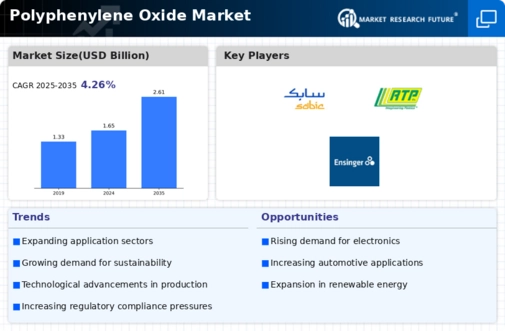Market Share
Polyphenylene Oxide Market Share Analysis
In the competitive landscape of the Polyphenylene Oxide (PPO) market, companies employ various market share positioning strategies to establish their presence and gain a competitive edge:
Product Differentiation: One of the primary strategies is to differentiate products based on unique features, performance attributes, or formulations. Companies invest in research and development to innovate and introduce PPO variants with enhanced properties such as heat resistance, impact strength, and chemical resistance. By offering differentiated products, companies can cater to specific market segments and attract customers seeking specialized solutions.
Cost Leadership: Some companies focus on achieving cost leadership by optimizing production processes, reducing manufacturing costs, and achieving economies of scale. By offering PPO products at competitive prices, these companies target price-sensitive segments of the market and aim to capture market share by undercutting competitors' prices while maintaining profitability through efficient operations.
Market Segmentation: Companies may adopt a market segmentation strategy to target specific industries, applications, or geographic regions where there is high demand for PPO products. By understanding the unique needs and preferences of different market segments, companies can tailor their marketing strategies, product offerings, and distribution channels to effectively penetrate and capture market share in these segments.
Vertical Integration: Vertical integration involves controlling multiple stages of the value chain, from raw material production to manufacturing and distribution. Companies may vertically integrate by acquiring suppliers of key raw materials, investing in manufacturing facilities, or establishing strategic partnerships with distributors. Vertical integration allows companies to streamline operations, ensure a reliable supply of raw materials, and capture a larger portion of the value chain, thereby enhancing market share.
Strategic Partnerships and Alliances: Collaboration with other companies, research institutions, or industry associations can be an effective strategy to strengthen market position and expand market share. Companies may form strategic partnerships to leverage complementary strengths, share resources, access new technologies, or enter new markets. By collaborating with key stakeholders, companies can enhance their competitive position and gain access to new customers and distribution channels.
Brand Building and Marketing: Building a strong brand reputation and implementing effective marketing strategies is crucial for gaining market share in the PPO market. Companies invest in branding initiatives, advertising campaigns, and promotional activities to increase brand awareness, establish credibility, and differentiate their products from competitors. By effectively communicating the value proposition of their PPO products and building strong brand equity, companies can attract customers and gain market share.
Customer Relationship Management: Fostering strong relationships with customers is essential for retaining existing customers and attracting new ones. Companies may implement customer relationship management (CRM) strategies to understand customer needs, provide personalized solutions, and offer superior customer service. By delivering exceptional customer experiences and building long-term relationships, companies can increase customer loyalty, enhance repeat business, and ultimately capture a larger share of the market.
Continuous Innovation: In the rapidly evolving PPO market, continuous innovation is critical for maintaining competitiveness and capturing market share. Companies invest in research and development to develop new PPO formulations, manufacturing processes, or applications that address emerging market trends, customer preferences, and industry regulations. By staying at the forefront of innovation, companies can differentiate themselves from competitors, meet evolving market demands, and solidify their market position.







Leave a Comment